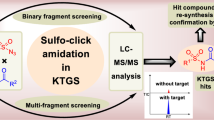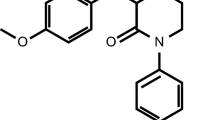Abstract
Purpose. Systemic and hepato-biliary clearance of peptidomimetic thrombin inhibitors of the 4-amidinophenylalanine amide-type, derived from NAPAP (Nα-[2-naphthylsulfonyl-glycyl]-4-amidinophenylalanine-piperidide) by substituting Gly in P2 for natural and unnatural amino acids or by varying the C- and N-terminal moieties, resp., were investigated.
Methods. Concentrations of the compounds administered as intravenous bolus injection at a dose of 1 mg/kg to bile duct-cannulated rats were determined in plasma and bile samples collected over 4 hours using reversed-phase HPLC.
Results. NAPAP and the derivatives with additional charged groups are comparatively hydrophilic compounds. For NAPAP and most of the derivatives the biliary clearance accounted for a high percentage of the rapid systemic plasma clearance. Derivatives 2a-c with a second basic group in P2 position showed lower systemic and biliary clearance compared to NAPAP, whereas their cumulative biliary excretion after a period of 120 min was less affected. Bis-benzamidine derivatives 4a and 5 with the second amidino group in the N-terminal moiety had the lowest biliary clearance. Additional carboxylic groups reduced the systemic and biliary clearance only as free amidinophenylalanine carboxyl in 3a and 5. No influence compared to NAPAP was observed for 2d with a free carboxyl group in P2 position.
Conclusions. The weak correlation of the log P values of the compounds with the clearance parameters indicates the influence of structural variations, especially of charged groups, in this series of compounds rather than overall lipophilicity on hepato-biliary elimination mediated by hepatocellular transporters.
Similar content being viewed by others
REFERENCES
J. B. M. Rewinkel and A. E. P. Adang. Strategies and progress towards the ideal orally active thrombin inhibitor. Curr. Pharm. Des. 5:1043–1075 (1999).
J. Hauptmann and J. Stürzebecher. Synthetic inhibitors of thrombin and factor Xa: from bench to bedside. Thromb. Res. 93:203–241 (1999).
M. R. Wiley and M. J. Fisher. Small molecule direct thrombin inhibitors. Expert. Opin. Ther. Patents 7:1265–1282 (1997).
P. E. J. Sanderson and A. M. Naylor-Olsen. Thrombin inhibitor design. Curr. Med. Chem. 5:289–304 (1998).
S. D. Kimball. Oral thrombin inhibitors: Challenges and progress. In A. C. G. Uprichard and K. P. Gallagher (eds.), Antithrombotics, Springer Verlag, Berlin Heidelberg New York, 1999 pp. 367–96.
K. Menear. Progress towards the discovery of orally active thrombin inhibitors. Curr. Med. Chem. 5:457–468 (1998).
J. Stürzebecher, F. Markwardt, B. Voigt, G. Wagner, and P. Walsmann. Cyclic amides of N?-arylsulfon-aminoacylated 4-amidinophenylalanine-tight binding inhibitors of thrombin. Thromb. Res. 29:635–642 (1983).
B. Kaiser, J. Hauptmann, A. Weiss, and F. Markwardt. Pharmacological charac-terization of a new highly effective synthetic thrombin inhibitor. Biomed. Biochim. Acta 44:1201–1210 (1985).
J. Hauptmann, B. Kaiser, M. Paintz, and F. Markwardt. Pharmacological characterization of a new structural variant of 4-amidinophenylalanine amide-type synthetic thrombin inhibitor. Pharmazie 44:282–284 (1989).
J. Hauptmann, B. Kaiser, M. Paintz, and F. Markwardt. Biliary excretion of synthetic benzamidine-type thrombin inhibitors in rabbits and rats. Biomed. Biochim. Acta 46:445–453 (1987).
T. Steinmetzer, A. Schweinitz, S. Künzel, P. Wikström, J. Hauptmann, and J. Stürzebecher. Structure-activity relationships of new NAPAP-analogs. J. Enzyme Inhibit. 16:241–250 (2001).
B. Gabriel, M. T. Stubbs, A. Bergner, J. Hauptmann, W. Bode, J. Stürzebecher, and L. Moroder. Design of benzamidine-type inhibitors of factor Xa. J. Med. Chem. 41:4240–4250 (1998).
J. Stürzebecher, D. Prasa, J. Hauptmann, H. Vieweg, and P. Wikström. Synthesis and structure-activity relationships of potent thrombin inhibitors: Piperazides of 3-amidinophenylalanine.J. Med. Chem. 40:3091–3099 (1997).
G. Dickneite, D. Seiffge, K. H. Diehl, M. Reers, J. Czech, E. Weinmann, D. Hoffmann, and W. Stüber. Pharmacological characterization of a new 4-amidinophenylalanine thrombin-inhibitor (CRC 220). Thromb. Res. 77:357–368 (1995).
J. Hauptmann and B. Kaiser. In vitro and in vivo comparison of arginine-and benzamidine-derived highly potent synthetic thrombin inhibitors. Pharmazie 46:57–58 (1991).
B. Kaiser, J. Hauptmann, and F. Markwardt. Studies on toxicity and pharma-cokinetics of the synthetic thrombin inhibitor D-phenylalanyl-L-prolyl-L-arginine nitrile. Pharmazie 46:131–134 (1991).
M. J. Hursting, K. L. Alfor, J.-C. Becker, R. L. Brooks, J. L. Joffrion, G. D. Knappenberger, P. W. Kogan, T. P. Kogan, A. A. McKinney, and R. P. Schwarz. Novastan (Brand of argatroban): A small molecule, direct thrombin inhibitor. Semin. Thromb. Hemost. 23:503–516 (1997).
U. G. Eriksson, L. Renberg, U. Bredberg, A.-C. Teger-Nilsson, and C. G. Regardh. Animal pharmacokinetics of inogatran, a low-molecular-weight thrombin inhibitor with potential use as an antithrombotic drug. Biopharm. Drug Dispos. 19:55–64 (1998).
T. Lave, R. Portmann, G. Schenker, A. Gianni, A. Guenzi, M. A. Girometta, and M. Schmitt. Interspecies pharmacokinetic comparisons and allometric scaling of napsagatran, a low molecular weight thrombin inhibitor. J. Pharm. Pharmacol. 51:85–91 (1999).
U. Eckhardt, W. Stüber, G. Dickneite, M. Reers, and E. Petzinger. First-pass elimination of a peptidomimetic thrombin inhibitor is due to carrier-mediated uptake by the liver-interaction with bile acid transport systems. Biochem. Pharmacol. 52:85–96 (1996).
L. R. Bush. Argatroban, a selective, potent thrombin inhibitor. Cardiovasc. Drug Rev. 9:247–263 (1991).
S. Ahmad, L. H. Yang, A. Ahsan, K. Fu, O. Iqbal, D. A. Hoppensteadt, B. E. Lewis, J. M. Walenga, and J. Fareed. Pharmacokinetics of argatroban in primates: Evidence on endogenous uptake. Int. Angiol. 19:126–134 (2000).
J. Q. Tran, R. A. Di Cicco, S. B. Sheth, M. Tucci, L. Peng, D. K. Jorkasky, M. J. Hursting, and L. J. Benincosa. Assessment of the potential pharmacokinetic and pharmacodynamic interactions between erythromycin and argatroban. J. Clin. Pharmacol. 39: 513–519 (1999).
S. K. Swan and M. J. Hursting. The pharmacokinetics and pharmacodynamics of argatroban: effects of age, gender, and hepatic or renal dysfunction. Pharmaco-therapy 20:318–329 (2000).
K. Hilpert, J. Ackermann, D. W. Banner, A. Gast, K. Gubernator, P. Hadvary, L. Labler, K. Müller, G. Schmid, T. B. Tschopp, and H. Van de Waterbeemd. Design and synthesis of potent and highly selective thrombin inhibitors. J. Med. Chem. 37:3889–3901 (1994).
J. H. Proost, J. Roggeveld, J. M. Wierda, and D. K. Meijer. Relationship between chemical structure and physicochemical properties of series of bulky organic cations and their hepatic uptake and biliary excretion rates. J. Pharmacol. Exp. Ther. 282:715–726 (1997).
G. E. Blakey, I. A. Nestorov, P. A. Arundel, L. J. Aarons, and M. Rowland. Quantitative structure-pharmacokinetics relationships: I. Development of a whole-body physiologically based model to characterize changes in pharmacokinetics across a homologous series of barbiturates in the rat. J. Pharmacokinet. Biopharm. 25:277–312 (1997).
J. Ishizaki, K. Yokogawa, E. Nakashima, and F. Ichimura. Relationships between the hepatic intrinsic clearance or blood cell-plasma partition coefficient in the rabbit and the lipophilicity of basic drugs. J. Pharm. Pharmacol. 49:768–772 (1997).
C. Neef and D. K. Meijer. Structure-pharmacokinetics relationship of quaternary ammonium compounds. Correlation of physicochemical and pharmacokinetic parameters. Naunyn-Schmiedeberg's Arch. Pharmacol. 328:111–118 (1984).
E. B. Hunter, S. P. Powers, L. J. Kost, D. I. Pinon, L. J. Miller, and N. F. LaRusso. Physicochemical determinants in hepatic extraction of small peptides. Hepatology 12:76–82 (1990).
Author information
Authors and Affiliations
Corresponding author
Rights and permissions
About this article
Cite this article
Hauptmann, J., Steinmetzer, T., Vieweg, H. et al. Influence of Structural Variations in Peptidomimetic 4-Amidinophenylalanine-Derived Thrombin Inhibitors on Plasma Clearance and Biliary Excretion in Rats. Pharm Res 19, 1027–1033 (2002). https://doi.org/10.1023/A:1016426724831
Issue Date:
DOI: https://doi.org/10.1023/A:1016426724831




